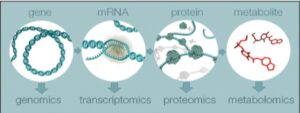01 Feb What is Metabolomics and How Does it Help with Diagnosis in the UDN?
By Devin Oglesbee and Ian Lanza | February 1, 2022
 Metabolomics refers to the study of the small molecules that are involved in many different metabolic pathways. An amino acid is an example of a metabolite, but there are thousands of unique metabolites in the human metabolome. These metabolites are chemical fingerprints that may be left behind by certain diseases when a particular metabolic pathway is affected by the expression of a gene or protein. Special laboratory techniques are used to detect these small molecules in patient samples and determine how they change over time, with treatment or disease to identify and understand rare diseases.
Metabolomics refers to the study of the small molecules that are involved in many different metabolic pathways. An amino acid is an example of a metabolite, but there are thousands of unique metabolites in the human metabolome. These metabolites are chemical fingerprints that may be left behind by certain diseases when a particular metabolic pathway is affected by the expression of a gene or protein. Special laboratory techniques are used to detect these small molecules in patient samples and determine how they change over time, with treatment or disease to identify and understand rare diseases.
Who are the investigators?
The metabolomics program began in the 1990’s at the Mayo Clinic, which today is home to world-class laboratories that work together to support UDN Clinical Sites – as well as clinicians and researchers around the world – in diagnosing and studying rare genetic disorders. The Metabolomics Core at Mayo Clinic joined the UDN in 2017. The Core has two main laboratories that work together with an interdisciplinary team of researchers. Dr. Ian Lanza, PhD, directs the Metabolomics Core Laboratory and Dr. Devin Oglesbee, PhD, directs the Clinical Biochemical Genetics Laboratory. In addition, Drs. Eva Morava Kozicz, MD, PhD, and Brendan Lanpher, MD are key collaborators in clinical research working with the Core, as are Drs. Surendra Dasari, PhD, in bioinformatics, and Ivan Vuckovic, PhD, from the Nuclear Magnetic Resonance Laboratory.
How does metabolomics help the UDN?
Metabolomics can assist scientists and physicians to identify new disorders. If a variant of unknown significance is identified in a patient with an undiagnosed disease, the UDN can perform metabolomics research to see if the metabolites in the patients with a particular genetic change and set of symptoms are distinct from patients without that variant or those symptoms. If a gene variant appears to be associated with a specific set of metabolites unique to that gene’s biological function, it would suggest that the variant plays a role in the disease manifestation. This analysis can also aid the understanding of how gene alterations affect the body and lead to disease. This information can also help the investigation of new treatments for unmet patient needs.
In addition to being experts at laboratory medicine and providing a full suite of clinical biochemical genetic testing, the UDN Metabolomics Core has novel methods for analyzing metabolites. This includes untargeted “metabolomic profiling,” which is the reporting of a relatively large profile of biological molecules, and “lipidomics,” which is the analysis of a complete set of accessible lipids in a biological specimen. One example of these sophisticated lab tests is glycan analysis, which uses complementary methods for accessing sugar chain-like content and structures on proteins (see image below) that can be altered during biological processes, like in the disorder, NGLY1. These types of tests require highly specialized equipment and expertise and are not possible at typical clinical laboratories.
According to Jill Mokry, UDN Coordinator at the Baylor College of Medicine, “The Metabolomics Core can be helpful in our hunt for clues to diagnose a UDN patient. Even if we haven’t yet arrived at a diagnosis, their tests can provide useful information. I can think of an example where we were able to order testing through the Metabolomics Core that helped us rule out a diagnosis. We found a change in a gene that we considered to be a candidate for causing the UDN participant’s symptoms. When this gene is not functioning properly, it causes metabolic changes. We weren’t sure if the change in the gene would be harmful to its function, but after getting normal results back from the metabolomics group, it helped us determine that this candidate was less likely to be the patient’s diagnosis, and we’ve been able to turn our attention to other candidate genes.”
“A Beautiful Partnership”
The interaction between researchers and clinicians at the Metabolomics Core provides an avenue for rapid UDN patient evaluation and laboratory analysis. “Our contribution to the UDN goes well beyond analytical chemistry” says Ian Lanza, Ph.D., director of the Metabolomics Resource Core Lab. “With the help of clinicians, Dr. Eva Morava-Kozicz and Dr. Brendan Lanpher, we are able to provide meaningful clinical insights into the metabolite signatures that we measure in patients. It’s a great example of a beautiful partnership between research and clinic.



